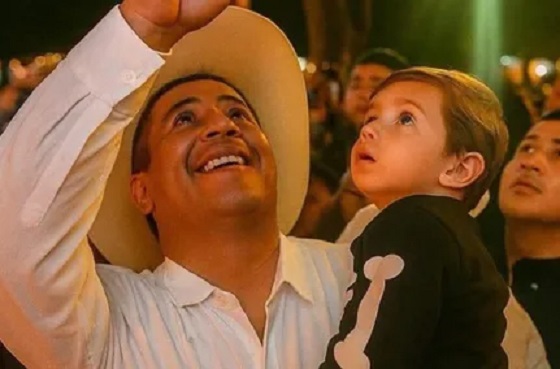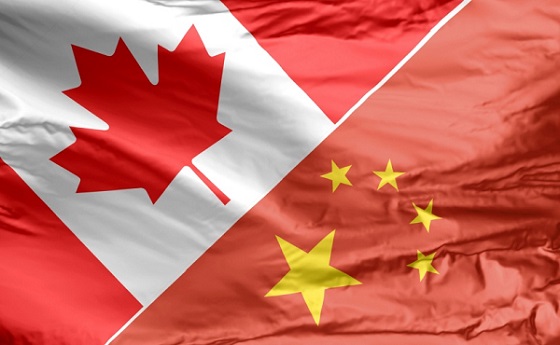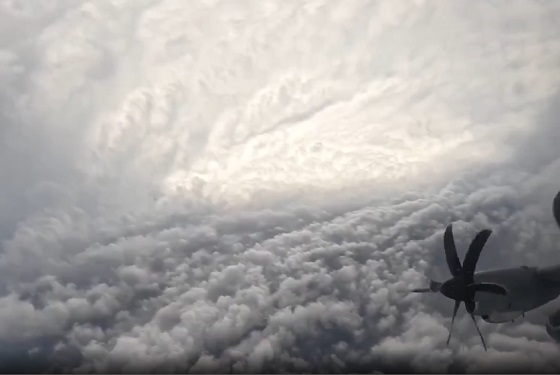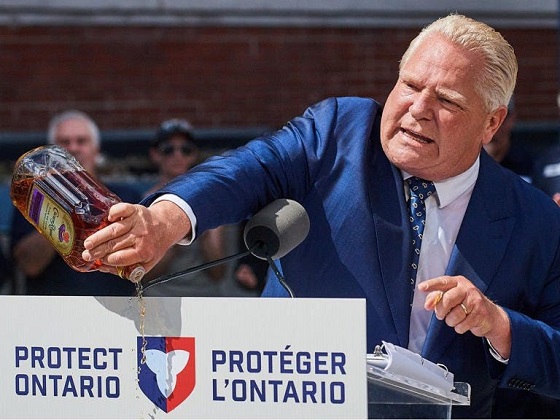International
Biden refers to Harris as ‘VP Trump’ during mistake-filled NATO presser
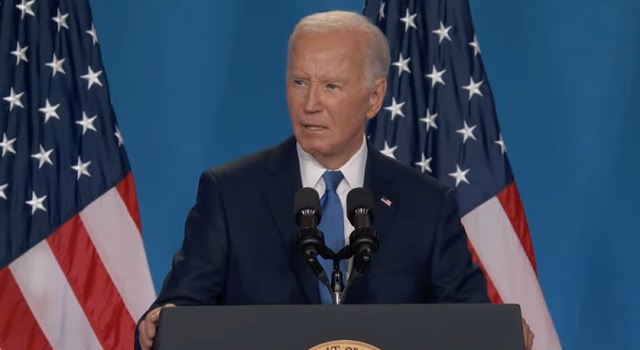
From The Center Square
News conference held as more Democrats call on Biden to step aside
In his first news conference since his critically panned debate performance two weeks ago, President Joe Biden on Thursday made numerous mistakes while talking for about an hour. He answered questions from 10 hand-picked reporters focused mostly on his fitness for office, but included issues such as the conflicts in Israel and Ukraine.
“I’ve been given a list of people to call on here,” Biden said when the Q&A portion of his news conference began, later mistakenly referring to Vice President Kamala Harris as “Vice President Trump.”
News outlets since Biden’s performance in the late June debate against former President Donald Trump have reported that Biden is tightly controlled by White House staff, some saying as efforts to hide the president’s cognitive decline. Because of Biden’s recent gaffes, many Democrats have called on Biden to step aside and allow the party to choose another candidate to run against Trump in November. Biden has been defiant, insisting he will stay in the race.
“I’m not in this for my legacy. I’m in this to complete the job that I started,” Biden said after he was asked whether his refusals to back out of the race might backfire and cost the Democratic Party the Oval Office, as well as down ballot races in Congress. Republicans hold a slight majority in the U.S. House, and Democrats in the Senate. Either or both could flip in November, depending on voter sentiment.
When asked if Harris was ready to become president if Biden did decide to step aside, the president said, “I wouldn’t have picked Vice President Trump to be vice president if I think she’s not qualified to be president. Let’s start there.”
Trump quickly mocked Biden for the flub on his Truth Social account.
“Crooked Joe begins his ‘Big Boy’ Press Conference with, ‘I wouldn’t have picked Vice President Trump to be vice president, though I think she was not qualified to be president,” Trump posted. “Good job, Joe.”
Biden also lost his train of thought several times during the news conference, ending his answers with “well, anyway” without finishing his response.
When asked if he was capable of performing the job of the presidency for another four years, Biden said he was but, “I’ve just got to pace myself more.”
Earlier in the day, Biden mistakenly called Ukraine President Volodymyr Zelenskyy “President Putin” during an introduction. Vladimir Putin is president of Russia, which invaded Ukraine more than two years ago.
Biden’s news conference came after he addressed the NATO summit on Thursday, highlighting the U.S.’ commitment to providing aid to Ukraine and the importance of unity among NATO members. Biden hosted the summit and the various world leaders in Washington, D.C. this week.
When asked during the news conference if he would reconsider the U.S. allowing Ukraine to use U.S. weapons in its war with Russia, Biden mistakenly said, ““I’m following the advice of my commander-in-chief.” As president, Biden is commander-in-chief of the U.S. military. He soon followed, “My, the chief of staff of the military, as well as the secretary of defense and our intelligence people.”
NATO is now 75 years old and holds the position as the world’s most powerful and far-reaching deterrence pact.
“The fact that NATO remains the bulwark of global security did not happen by accident,” Biden said at the summit’s opening ceremony Wednesday. “It wasn’t inevitable. Again and again, at critical moments, we chose unity over disunion, progress over retreat, freedom over tyranny and hope over fear. Again and again, we stood behind our shared vision of a peaceful and prosperous Transatlantic community.”
According to the U.S. Defense Department, NATO has provided at least $175 billion to Ukraine, including guns, fighter jets, ammunition and training.
Trump has long been critical of the alliance, highlighting an over-reliance on U.S. monetary aid and defense funding.
Trump’s threats of non-protection over members not paying their dues has many in Europe worried about his commitment to the alliance.
“‘If we don’t pay, are you still going to protect us?’ I said ‘absolutely not,'” Trump said at a campaign rally in South Carolina, remarking an interaction he had with one supposed member president.
Though a unilateral withdrawal from the alliance is not possible, there has been speculation about plans that would restructure the alliance so as to rely less on U.S. funding and defense platforms.
Agriculture
Danish Cows Collapsing Under Mandatory Methane-Reducing Additive

Cow feed additive Bovaer meant to curb climate change seems to be killing some Danish dairy cows
Since October 1, 2025, when many Danish dairy farmers began incorporating the synthetic additive Bovaer (containing 3-nitrooxypropanol) into their cows’ feed—alarming reports have come in of animals suffering from: stomach cramps, fevers, miscarriages, drastic drops in milk production, sudden collapses and in some cases, the need to be euthanized.
The first farmer from Denmark comes forward and talks about sick and dead cows, after giving his cows the Bovaer poison. 10/28 25. Remember that waste products from Bovaer, are passed on in milk and meat.
Short version video.
Boycott Arla and share, share, share. pic.twitter.com/fXzHgfWP3G
— Kent Nielsen Denmark (@Kentfrihedniels) October 30, 2025
In the shocking video below, Danish farmer Rene Lillehjælper discusses how her husband is driving their “cow ambulance” tractor— transporting yet another collapsed cow from their dairy farm—because of the “Bovaer Poison.”
Marketed as a “climate-friendly” methane reducer, this product—produced by the Dutch-Swiss giant DSM-Firmenich—became a legal requirement for Danish dairy farmers to add into their animal feed for 80 days or for their cows to be fed extra fat throughout the year.
Notably, farmers experimenting by removing Bovaer saw their herds recover rapidly, only for symptoms to return upon reintroduction. Yet, despite these red flags, authorities insist on pushing ahead, with an investigation only now underway.
These reports build on the concerns I outlined in my November 2024 investigation into Arla’s UK trials, where EFSA tolerance studies highlighted issues such as reduced feed intake, decreased organ weights (including ovaries and heart), and altered enzyme levels in cows at elevated doses—yet these effects were ultimately classified as “non-adverse” by regulators.
BREAKING: Methane-Reducing Feed Additive Trialled in Arla Dairy Farms
On November 26th, Arla Foods Ltd. announced via social media their collaboration with major UK supermarkets like Tesco, Aldi, and Morrisons to trial Bovaer, a feed additive, aiming to reduce methane …
What was even more troubling were the findings from my analysis of the safety assessment report, prepared by the UK’s Food Standards Agency (FSA) and Food Standards Scotland (FSS), reviewed by Animal Feed and Feed Additives Joint Expert Group (AFFAJEG) and the Advisory Committee on Animal Feedingstuffs (ACAF).
It stated: “In relation to safety studies for the consumer, a 2-year carcinogenicity study in Wistar rats showed “mesenchymal cell tumours were reported in 4 out of 49 females at the top dose of 300 mg/kg bw/day of 3-NOP given orally. Based on these results, the original study report concluded there was evidence of carcinogenicity in female rats.”
AFFAJEG noted potential for mesenchymal cell hyperplasia and benign tumours at high doses but, citing no malignant tumours or genotoxicity, concluded the additive is not carcinogenic at recommended inclusion rates.
ACAF echoed that the additive “can be considered safe for consumers.” Yet, their conclusion was seemingly contradicted by the following statement: “The additive should be considered corrosive to the eyes, a skin irritant and potentially harmful by inhalation.”
In a separate development, a May 2024 FDA letter addressed to Elanco US, Inc, (which has an agreement with DSM-Firmenich to market Bovaer) stated: “Based on a review of your data and the characteristics of your product, FDA has no questions at this time regarding whether Bovaer® 10 will achieve its intended effect and is expected to pose low risk to humans or animals under the conditions of its intended use.”
Ironically, the FDA letter included an attachment with the following warning:

It should be noted that Bovaer passed the FDA review in under 12 months—much shorter than industry standard.
Kjartan Poulsen, chairman of the National Association of Danish Dairy Producers, has received numerous calls from concerned farmers. “We have so many people who call us and are unhappy about what is happening in their herds,” he shared with TV 2.
He described the recurring issues as unusual and is urging reports of suspected Bovaer-linked miscarriages. Poulsen emphasized that any animal harm undermines the additive’s purpose: “This should give a climate effect – and if cows die from this, or they produce less milk, then the effect is minus.” He is calling for a temporary pause from Agriculture Minister Jacob Jensen and for farmers to cease use if welfare issues arise.
Approved by the European Commission in 2022 based on EFSA assessments, Bovaer was deemed safe for cows, consumers, and the environment, with claims of up to 30-45% methane reduction.
However, field experiences differ. Reports from Jyllands-Posten and TV 2 describe lower milk yields tied to miscarriages, plus collapses—some cows recovering with treatment but others needing to be euthanised.
Earlier whispers from Danish farmers included fevers, diarrhoea, mastitis, and even cow deaths attributed to Bovaer. One producer lost six animals in under a month. Critics label it “animal cruelty,” especially under mandatory use for farms with over 50 cows.
The Danish Veterinary and Food Administration acknowledges these reports and has enlisted Aarhus University to analyse real-world data, with initial findings expected after the 2025-26 new year.
The irony is stark: a product meant to “save the planet” for reducing methane is harmful to dairy herds, slashing productivity, and raising fears of contaminating the food chain—despite assurances it “breaks down fully” with no residues.
Yet, the true winners emerge clearly: DSM-Firmenich, cashing in on booming sales fuelled by mandates and climate subsidies, alongside powerhouse investors like BlackRock (holding ~3.3%) and Vanguard, who reap the rewards from this relentless Net-Zero drive.
If you appreciate the hard work that I do as an independent investigative journalist,
please consider supporting me with a paid subscription.
Economy
Welcome to the Energy Humanist Club! Bill Gates breaks the moral monopoly against fossil fuels
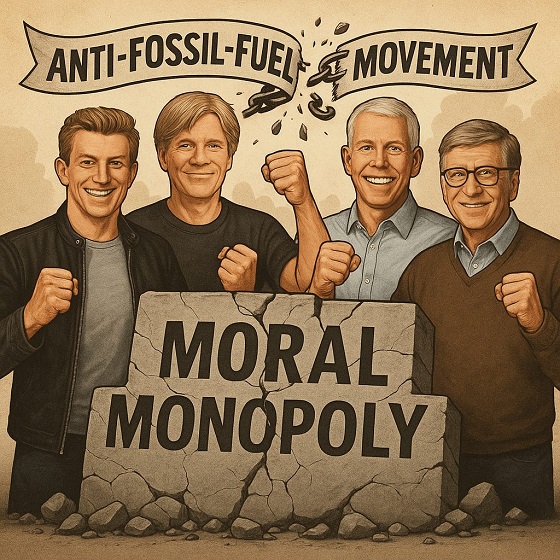
Bill Gates’s humanist challenge to the anti-fossil-fuel climate establishment was only possible because the “moral monopoly” against fossil fuels has been breaking. Now it will break even faster.
Bill Gates brings human-centric thinking to international climate politics
Early last week, Bill Gates released a viral memo about rising GHG levels, “Three tough truths about climate,” purporting to be a “new way to look at the problem,” ahead of the influential COP (Conference of the Parties) climate conference.
The core of the memo, the supposed “new way to look at the problem,” will be very familiar to those who have read my work or that of other “energy humanists,” such as Bjorn Lomborg, Steve Koonin, and Michael Shellenberger.
“We should measure success by our impact on human welfare more than our impact on the global temperature,” which means we should reject “climate policies” where “human welfare takes a backseat to lowering emissions, with bad consequences.”
On the basis of this human-centric “new way to look at the problem,” Gates challenges the two most sacredly held tenets of the global anti-fossil-fuel movement:
- Climate catastrophism: “Although climate change will have serious consequences…it will not lead to humanity’s demise. People will be able to live and thrive in most places on Earth for the foreseeable future.”
- Net-zero by 2050 (to limit temperatures from rising to 1.5 or 2 degrees C above pre-industrial levels): “refocus on the metric that should count even more than emissions and temperature change: improving lives.”
While neither Gates’s human-centrism nor his challenges to the anti-fossil-fuel movement are new to the expert conversation about climate, what is new is that one of the biggest thought-and-action leaders in international climate politics would take this position.
This has generated great excitement in the energy humanist community and in the broader pro-human and pro-freedom communities, since the world of international politics listens when Gates—the world’s largest philanthropist and a huge influencer of government aid—speaks.
Gates’s mind didn’t change, his incentives changed—which is even more fortuitous
I think there’s even more cause for excitement than one might think, because what’s happening is far more significant than what it appears to be, which is one very (very) influential person publicly changing his mind.
What’s actually happening is not that Gates has changed his mind—there is ample evidence he’s long held the key tenets of his new memo. What’s happening is that the intellectual, economic, and political environment has changed so much and so quickly that Bill Gates, one of the shrewdest, most calculating people on Earth, after authoring a conventional climate catastrophist book just a few years ago, feels incentivized to challenge the global anti-fossil-fuel movement’s anti-humanism, catastrophism, and ruinous net-zero obsession.
If we understand how this happened, which I will argue is through the mechanism of “breaking a moral monopoly,” we can achieve even more rapid progress in the near future.
The leverage of breaking a “moral monopoly”
In “Reframing the Conversation,” the final chapter of Fossil Future—which was written between 2018 and 2021—I made the case that the anti-fossil-fuel movement could be stopped, despite the fact (at the time) “that today’s world is starting to head in the deadly direction of fossil fuel elimination—and that support for that direction is so overwhelmingly massive.”
How could I make that case, at a time when every major government, corporation, financial investor, and cultural institution seemed confidently united in support of rapidly eliminating fossil fuels? Because I believed that the seemingly insurmountable anti-fossil-fuel movement was based on an easy-to-refute set of anti-human and false ideas—which I call “the anti-impact framework”—that seemed powerful only because it had a “moral monopoly.”
The fossil fuel elimination movement is an incredibly fragile creature. It is based on the indefensible anti-impact framework, which has an anti-human goal (eliminating human impact in general and CO2 emissions in particular), a false and anti-human view of the planet (the delicate nurturer assumption), and a thoroughly irrational method of evaluation (ignoring benefits and catastrophizing side-effects).
The fossil fuel elimination movement is powerful only because it has a moral monopoly, meaning that it is widely considered the only moral position. Anything with a moral monopoly ends up attracting huge numbers of opportunistic people seeking status (and money) by associating with something uncontroversially good. But if that monopoly is broken, these opportunistic followers scatter.
Once one understands the power and fragility of an undeserved moral monopoly, an inspiring implication emerges: “To change the trajectory of the culture we don’t need to try to change everyone’s mind on this issue. What we really need to do is something much easier: we need to break the moral monopoly of the moral case for eliminating fossil fuels.”
I was optimistic that the moral monopoly of the anti-fossil-fuel movement could be broken for two reasons: 1) the reality of anti-fossil-fuel policies would be far more negative than people expected, and 2) the power of “reframing” the energy/climate conversation from a humanistic perspective was far more powerful than people imagined.
Reality was always a threat to the moral monopoly against fossil fuels
On the reality of anti-fossil-fuel policies being negative, I wrote:
One factor that will contribute to breaking the moral monopoly against fossil fuels is reality.
Already we are seeing clear evidence that there’s something wrong with the policies of the anti-fossil fuel movement. As I’ve been writing this book, my adopted home state, California, has been besieged by blackouts due to overreliance on unreliable solar and wind.
Around the world there are popular movements against the higher energy prices brought about by “green” policies…
At the same time, countries that take energy seriously, like China and India, are using and will continue to use more fossil fuels, exposing the lie that green energy will rapidly replace fossil fuels.
Soon enough, events will reveal more and more glaringly that being anti-fossil fuel is a truly destructive position.
One aspect of energy reality I highlighted in Fossil Future was the “effectively unlimited” need for energy to power AI / machine learning:
There are two features of the machine-learning revolution that are crucial to recognize when it comes to energy: it is extremely energy intensive—involving rapidly growing numbers of power-hungry computers—and the need for it is effectively unlimited. While we are going to want only so much energy to produce our food, there is no limit to the amount of life-improving computation we want…
While all of the above predictions have come true, it has turned out that AI’s effectively unlimited need for energy was the part of reality that has most broken the moral monopoly against fossil fuels.
The reason is that AI quickly generated a rapid increase in (highly influential) tech giants’ need for energy, specifically reliable electricity. This need quickly turned climate catastrophism and fossil fuel elimination from wealth-and-status benefiters for tech giants to wealth-and-status destroyers.
As I documented in Tech giants’ self-made AI energy crisis, “For years tech giants have been helping climate catastrophists shut down reliable fossil fuel electricity, falsely claiming they can be replaced by solar/wind. Now the grid they’ve helped gut can’t supply their growing AI needs.”
Just a few years ago, Meta, Google, Microsoft, and other tech giants were promoting climate catastrophism and calling for “net zero” (i.e., fossil fuel elimination) by 2050.
This helped their wealth and status. They could appear “green,” get international praise, and look good to potential customers by going along with the trends and (most damagingly) using their wealth and influence to continue the anti-fossil-fuel trends.
Of course these companies needed massive amounts of fossil fuels, but that need could be disguised by 1) having coal-dominated China produce a lot of the needed infrastructure for digital tech and 2) lying about their electricity usage being “100% renewable” and/or “net zero” through the use of fraudulent-but-legal “energy credits” that allow them to take credit for others’ solar and wind electricity use and blame others for their (massive) fossil fuel electricity use.
Tech giants’ anti-fossil-fuel stance could only last as long as US electricity demand remained stagnant. As soon as AI projections revealed that huge amounts of additional, reliable electricity were needed, tech giants’ interest in electricity necessarily shifted from fraudulently relabeling portions of a stagnant electricity supply in their favor to actually securing a lot more reliable electricity. And most of that electricity needed to come from fossil fuels—specifically natural gas (in large part because the government had so thoroughly gutted the ability to develop new coal power).
Once new fossil fuel electricity was clearly needed for AI success, tech giants’ wealth-and-status calculation shifted from being anti-fossil-fuel to pro-fossil-fuel, and their public positions and private actions changed with impressive rapidity given how much and how recently they said they were worried about a fossil fueled climate catastrophe.
Perhaps the most revealing shift was from Larry Fink, head of BlackRock, which owns huge shares of the public tech giants as well as countless other big public companies. In the early 2020s, Fink was called “the emperor” for his influential ESG pronouncements that everyone had to go net-zero or else, which were backed by a seeming conviction in avoiding a fossil-fueled climate catastrophe by a rapid “energy transition” that would somehow rapidly replace fossil fuels with unreliable solar and wind.
But once AI’s massive, reliable electricity demand became clear, Fink, at of all places the World Economic Forum (close to ground zero for corporate anti-fossil-fuel views), declared, “The world is going to be short power. To power these data companies you cannot have just this intermittent power like wind and solar, you need dispatchable power, cause you can’t turn off and on these data centers.”
While changing energy realities provided crucial raw material for breaking the anti-fossil-fuel moral monopoly, events by themselves without the required framing and arguments do not cause major intellectual shifts, because the monopoly side usually warps events (e.g., advocates of subsidized unreliable power have absolved themselves of blame for the Texas blackouts, rising electricity prices, and Europe’s dangerous dependence on Russian gas.) In Fossil Future I argued that in order for that monopoly to break, enough of us need to “reframe” the conversation: “As events unfold, if enough of us are reframing the conversation…there will be rapid uptake of the truth.”
Why “reframing” is the key to breaking the moral monopoly against fossil fuels
“Reframing” the energy/climate conversation from a humanistic perspective has been the core of my work on this issue for 18 years. I highly recommend (re)reading the final chapter of Fossil Future for a full account of the mechanics of reframing. But the basic idea is to, instead of adopting the basic way of thinking the establishment anti-fossil-fuel movement does (e.g., our number one goal should be emissions reduction) then quibbling about details, explicitly advocate for thinking about energy and climate in a different way:
-
a pro-human vs. anti-human way: our ultimate goal and standard is advancing human flourishing on Earth, not eliminating human impact on Earth
-
an evenhanded vs. biased way: we evaluate fossil fuels and any other technology by carefully weighing benefits and side-effects (negative and positive), not by ignoring benefits and “catastrophizing” side-effects
In Fossil Future, I highlighted the persuasive success that I and other energy humanists, such as Bjorn Lomborg, Matt Ridley, Robert Bryce, and Michael Shellenberger had had in arguing for the morality of fossil fuel use as an enormous net-benefit to humans (including making our naturally dangerous climate far safer)—a direct and powerful challenge to the anti-fossil-fuel moral monopoly.
I specifically highlighted our success challenging the “false monopoly on science” the anti-fossil-fuel movement (undeservedly) claims while smearing fossil fuel supporters as “climate science deniers.” Energy humanists properly embrace real climate science by integrating it into an overall humanistic analysis “in which one considers the issue of fossil fuels’ impact on climate in its full context from a human flourishing perspective—and even though fossil fuels do impact climate, that’s not necessarily even negative, and even if it is negative it can be possible that fossil fuels’ positives far outweigh it.”
I predicted: “As I and other energy humanists rise in prominence and continue to reframe the conversation…No longer will it be possible to smear fossil fuel advocates as ‘climate change deniers’” and the anti-fossil-fuel movement’s “false monopoly on science…will start to break.”
As I had hoped, the reality of how bad anti-fossil-fuel policies were for human life and progress, combined with a growing army of energy humanists and arguments reframing energy and climate developments, energized more public energy humanists (e.g., Lucy Biggers, Matthew Wielicki, Chris Martz, Jusper Machogu), more energy humanist arguments, and more people hearing those arguments (e.g., Joe Rogan, Jordan Peterson, Lex Fridman).
In late 2024, another development took the energy humanist challenge to the anti-fossil-fuel monopoly to a new level: a new US administration steeped in energy humanism and alarmed about the energy reality caused by anti-fossil-fuel policies.
How reality and reframing have helped the second Trump administration break the anti-fossil-fuel moral monopoly
As I discussed recently on Fox News’s Will Cain Show, the second Trump administration has obviously been a big source of political, economic, and cultural pressure against climate catastrophism and for the unleashing of fossil fuels (along with all other forms of cost-effective energy).
In an era where tech executives need to work very closely with the government to reach their AI goals, the second Trump administration compared to the preceding Biden administration is obviously one that would make Bill Gates far more comfortable speaking up and encouraging the international “climate change” (anti-fossil-fuel) movement to reject climate catastrophism, net-zero policies, and, most importantly, anti-human thinking.
But it would be a mistake to attribute this to just a combination of emerging energy realities plus Donald Trump and his long-standing support of fossil fuels and opposition to climate catastrophism. The new Trump administration has itself been hugely influenced, by not just reality but reframing.
Note that, notwithstanding the first Trump administration doing many good things on energy, the second Trump administration is on a completely different level in terms of making unleashing energy—including opposing climate catastrophism—a central, overarching, and intransigent focus.
For example, on the climate catastrophism issue, the first Trump administration chose not to take on the EPA “endangerment” finding at the root of much of US anti-fossil-fuel policy, while the second Trump administration made it an immediate priority.
The first Trump administration was significantly influenced by figures sympathetic to climate catastrophism, such as David Banks, a Republican “climate hawk” who advocated participation in the Paris climate framework. The second Trump administration, by contrast, is consistently at war against climate catastrophism and obsessed with unleashing American energy, above all American fossil fuel energy.
Reality certainly plays a big role here. This administration’s energy leaders, like many of us, have seen the destructive consequences of the Biden energy policies and their more consistent equivalents in Europe. They saw Europe deindustrializing and dangerously dependent on Russian natural gas. They saw catastrophic blackouts in California and Texas. And above all they saw AI emerging and our grid, handicapped by two decades of anti-fossil-fuel policies, totally unequipped to handle it.
But crucially, they’ve seen these developments through the frame of energy humanism, which has given them a level of intransigence that would otherwise be impossible.
Energy humanism in this administration is most obvious with the Secretary of Energy, Chris Wright, himself one of the top 10 energy humanist intellectuals in the world (we debated some climate catastrophists together back in 2015). Wright courageously challenged anti-fossil-fuel ESG thinking at its peak of popularity and countering cowardly “sustainability” ESG reports with his own pro-fossil-fuel “Bettering Human Lives” report that focused on all the good his and other fossil fuel companies did.
It’s not just Chris Wright, though. The new Administration is permeated by energy humanists. Doug Burgum, who is both Secretary of the Interior and Chairman of the National Energy Dominance Council, has long adopted the energy humanist approach as a very pro-energy Governor of North Dakota.
When I spoke at a North Dakota event in 2023, Burgum introduced me and specifically highlighted philosophy and ideology: “This guy gets it. He’s a philosopher. He’s helping leaders to set policy, to understand the words that work to help describe and push back against this ideology that’s trying to basically undermine our grid, undermine our economics, and undermine our national security.”
Beyond Burgum and Wright, there are literally hundreds of people in the Administration and Congress that I know for a fact have been significantly influenced by energy humanism.
Thanks to energy humanism permeating the Trump administration and Congress, a confident, pro-human advocacy of fossil fuels and a disdain for climate catastrophism emanates from DC and makes it a lot easier for new people to speak up from the same perspective. This, along with the reality of the anti-fossil-fuel movement’s energy failures and the overall growth of energy humanism, is the context in which Bill Gates wrote his memo.
The Gates memo is a major new ratcheting of the energy humanist position breaking the anti-fossil-fuel moral monopoly
Much commentary on the Gates memo describes it as Gates changing his mind on energy and climate issues.
But, having closely followed Gates’s thinking for quite some time, I don’t think Gates’s mind has meaningfully changed about the truth of how to think about, and make policy on, fossil fuels and climate. In fact, I think he’s long disagreed with climate catastrophism and believed in humanism to a greater extent than even his recent memo conveys.
What is notable about Gates’s memo isn’t a mind change but an incentive change. The intellectual, political, and economic environment has changed a lot, to the point where Bill Gates now considers it acceptable and even advantageous to tell more of the truth about his views.
Make no mistake, Bill Gates is an incredibly calculating person. It has been a big cause of his business success and it’s the reason why his public comments about energy and climate shift with the winds.
E.g., in 2016, before peak “net zero”, he was willing to be critical of solar and wind’s deficiencies but during peak “net zero” he warned of looming climate disaster and chose to publish a book “How to Avoid a Climate Disaster.” He funded The Guardian, a leading source of anti-fossil-fuel propaganda and climate catastrophism. And he participated in the whole international anti-fossil-fuel “climate change” movement financially and intellectually with little criticism of its anti-human and ultimately murderous quest to rapidly eliminate fossil fuels in a world that needs far more energy.
But now that we’re in an AI era where Gates’s business interests require a lot more fossil fuels—and everyone else’s in his orbit do, too—and the administration loves fossil fuels and hates climate catastrophism—and energy humanism has become a more acceptable position—Gates feels comfortable explicitly advocating a humanistic perspective and opposing climate catastrophism.
Here’s the great thing about that: Because of Gates’s status, above all in the international climate world where energy humanism has least taken hold, Gates’s memo will make it far easier for some key people to tell the truth.
What’s happening here is a major ratcheting in energy humanism breaking the anti-fossil-fuel moral monopoly.
Moral monopolies don’t get broken all at once, even if there is sufficient understanding among influential people to break them because many of those who understand are so disincentivized from speaking up. The more absolute the moral monopoly, the higher cost there is to challenging it.
The early challengers will be ignored, marginalized, or, if they can manage to get a hearing, demonized. But the early challengers, if persuasive and at all popular, make it just a little easier for the next round of challengers to speak up. And once the next round speaks up, it’s a little easier for the next round. And so on.
If the moral monopoly is invalid and the challenger is valid, as is the case for anti-fossil-fuels vs. energy humanism, each successive wave of prominent challengers has a ratcheting effect—it sticks in a way that can’t be pushed back, because the once-suppressed basic truths, now seen, can’t be unseen. The only direction to go is forward.
Bill Gates speaking up for a human-centered approach to GHG emissions is a major ratchet. He’s said something explicit that is very hard to argue with: “We should measure success by our impact on human welfare more than our impact on the global temperature,” which means we should reject “climate policies” where “human welfare takes a backseat to lowering emissions, with bad consequences.”
Even if/when certain parts of the incentive environment change (e.g., a new Administration) it’s hard to imagine Gates reversing his position.
But it’s very easy to imagine, even inevitable, that Gates’s new stance will make it easier—much easier—for the next influencers to challenge and help break the anti-fossil-fuel moral monopoly.
In the tech world, legendary software engineer and entrepreneur “DHH”—David Heinemeier Hansson”—showcased this by responding to a commentary about the Gates memo by energy humanist Lucy Biggers (who I’m proud to share has credited Fossil Future for heavily influencing her thinking) with far better comments than Gates’s.
“Europe would do well to follow Gates on this pivot. The EU is responsible for just 6% of global emissions, but still thinks it’s saving the planet by sorting and washing trash by hand, forgoing AC, or deleting emails (lol). Climate doomerism is degrowth nonsense in a nutshell.”
When asked, “If the West doesn’t lead by example, do we think the rest of the world will follow?” DHH answered:
“There’s no example to lead for. The Eurobrain is focused on degrowth, limiting energy use, and virtue-signaling trash sorting. None of that is worth imitating. We should be focused on abundant energy, economic expansion, and embracing technology (like trash sorting robots).”
As far as I can tell, DDH has long held these views, but only started voicing them this year with the Gates memo unleashing a new level of directness. I am looking forward to more tech leaders making such comments. But what I’m looking forward to most of all is what happens in international goal-setting and policy-making.
Energy humanist ratcheting in international climate politics
The core of our energy problems is the international anti-fossil-fuel movement, led by the UN.
As I’ve argued over the years, this is a deeply anti-human and irrational movement that legitimatizes itself by engaging with a lot of good climate science (in addition to bad) under the auspices of the Intergovernmental Panel on Climate Change (IPCC).
Of all the parts of what I call “the knowledge system,” international climate politics has proven the most immune to energy humanism—in my view due to how entrenched its leaders’ statuses are based on climate catastrophism and the fact that from its founding it has attracted power-lusting anti-humanists (the current UN Secretary General is a good example).
It’s hard to imagine many people who could directly break this part of the anti-fossil-fuel moral monopoly with energy humanism. But Bill Gates, as the world’s leading philanthropist, who both gives huge amounts of money and influences many other billionaires, is in a unique position to disrupt things.
As evidence, him writing a long blog post just totally overtook international media and will surely be a central topic at the upcoming COP 30 climate conference in Brazil.
In my view the enduring effect of Gates’s memo will not primarily be its conclusions (which, while better than the anti-fossil-fuel movement’s, are very flawed and based on very sloppy analysis), but its reframing of the energy and climate conversation around the goal and standard of increasing human welfare.
“…our climate strategies need to prioritize human welfare. This may seem obvious—who could be against improving people’s lives?—but sometimes human welfare takes a backseat to lowering emissions, with bad consequences.”
In Fossil Future I discuss my “thrilling discovery” of the power of reframing: “I could do something relatively easy”—getting agreement with an idea that’s common sense but not common practice in a given discussion—“that would then frame the conversation in a way that would make it far easier for the other person to understand and agree with my evaluation of fossil fuels.”
For example, when discussions of energy and climate issues are explicitly reframed in terms of is overall best for “human welfare” (or the term I prefer, “human flourishing”) listeners are far more likely to actually look at the pros and cons of fossil fuels for human life vs. just treat their climate side-effects as an infinite evil to be eliminated at all costs.
Bill Gates is now doing this reframing in the belly of the beast, international climate politics—the most influential and anti-human part of the moral monopoly against fossil fuels.
What will happen now that human-centered framing is explicitly part of international climate politics?
It’ll be positive no matter what, but as computer legend Alan Kay said, “The best way to predict the future is to invent it.” Here’s what I think we need to do next to make the future better.
Be very happy—but don’t be or act remotely satisfied
A common response I saw to the Gates memo was some kind of declaration of victory or at least satisfaction because of the degree of Gates’s public shift away from climate catastrophism.
But note that Gates is still quite anti-fossil-fuels. And in any case, the deadly anti-fossil-fuel movement still dominates leading institutions around the world.
I believe being satisfied when so much more progress is needed is a big mistake that comes from what I call “the moral outcast posture.”
Those of us who have been against the anti-fossil-fuel moral monopoly have been frequently treated as outcasts—“climate change deniers,” “delayers,” etc. And people in the fossil fuel industry were for a long time treated similarly when they interacted with those outside the industry.
When one gets treated this badly, it’s easy to internalize the idea that one is somehow naturally an outcast. This manifests in a “moral outcast posture” wherein one acts like their mistreatment by others is somehow okay and deserved, and where better treatment is met with gratitude and satisfaction.
The outcast posture is particularly understandable among people who are pro-fossil-fuels but don’t know inside-out how anti-human and irrational the anti-fossil-fuel position is. (Many in the industry fit this description.)
Since I’ve been fortunate enough to spend 18 years thinking honestly about energy issues, I have been able to avoid the moral outcast posture. I think I’ve felt about being pro-fossil-fuels the way abolitionists felt about supporting freedom from slavery in the early 1800s. Even though so many disagree with me on fossil fuels, I believe deeply that it’s a product of them being locked in a false and anti-human framework that will one day be rightly seen as wrong.
When the mainstream makes a concession in the direction I believe is true, I’m happy for the progress. But I’m not satisfied—because the mainstream is still really wrong.
That’s how I feel about Bill Gates’s memo in particular and the state of energy and climate politics in general. It’s still really, really bad—for example, ignoring most of fossil fuels’ benefits, including climate-related benefits—and energy humanism is really, really good.
I believe that this intransigent support of energy humanism in general and fossil fuels in particular is what has gotten the ratcheting I am happy about now, and saying it going forward will be crucial for future ratcheting.
It’s people like Chris Wright, Bjorn Lomborg (evidence shows he’s the most influential energy humanist on Gates), and, yes, me. It’s people who said there was a moral case for fossil fuels and a fossil future, not the people who said, “Fossil fuels aren’t quite as bad as they used to be” or “Fossil fuels aren’t quite as bad as you think.”
Now that we are winning, we need to keep fighting harder. Ratcheting becomes easier over time, because there’s a lower and lower penalty for speaking the truth, so now is the time to step on the gas.
Personally, I will soon systematically refute all the bad things in the Gates memo and argue that while its basic moral framework is rightly humanistic, its analysis is biased, sloppy, and gives a lot of bad guidance. I will continue to call on COP to fundamentally change (or disband), not just shift a little bit—and encourage political and cultural leaders to do the same.
I encourage you to share these and other resources widely while we benefit from not just the Gates ratcheting (which should endure) but media momentum (which doesn’t last long). And, crucially, when you’re sharing good resources make clear that you agree with Bill Gates’s framing that we need to think about energy and climate issues from the perspective of advancing human flourishing on Earth, not minimizing human impact on Earth.
Here are some talking points to get started with.
- The irrefutable case for a Fossil Future
- Every “net zero by 2050” myth, refuted
- Energy Sound Bites on Fossil Fuels, parts 1, 2, and 3
So, fellow energy humanists. Let’s be very happy with the victories we’ve won. But let’s not be satisfied until the world consistently thinks and acts in a pro-human way toward energy: the industry that powers every other industry, the technology that powers every other technology, and a fundamental requirement of global human flourishing.
Questions about this article? Ask AlexAI, my chatbot for energy and climate answers:
Popular links
- EnergyTalkingPoints.com: Hundreds of concise, powerful, well-referenced talking points on energy, environmental, and climate issues.
- My new book Fossil Future: Why Global Human Flourishing Requires More Oil, Coal, and Natural Gas—Not Less.
- Speaking and media inquiries
“Energy Talking Points by Alex Epstein” is my free Substack newsletter designed to give as many people as possible access to concise, powerful, well-referenced talking points on the latest energy, environmental, and climate issues from a pro-human, pro-energy perspective.
-

 International2 days ago
International2 days agoNigeria better stop killing Christians — or America’s coming “guns-a-blazing”
-

 Daily Caller22 hours ago
Daily Caller22 hours agoTrump Reportedly Planning Ground Troops, Drone Strikes On Cartels In Mexico
-

 Alberta14 hours ago
Alberta14 hours agoAlberta government’s plan will improve access to MRIs and CT scans
-

 Alberta1 day ago
Alberta1 day agoCanada’s heavy oil finds new fans as global demand rises
-

 Aristotle Foundation2 days ago
Aristotle Foundation2 days agoB.C. government laid groundwork for turning private property into Aboriginal land
-

 Justice2 days ago
Justice2 days agoA Justice System That Hates Punishment Can’t Protect the Innocent
-

 Business22 hours ago
Business22 hours agoTrump’s Tariffs Have Not Caused Economy To Collapse
-
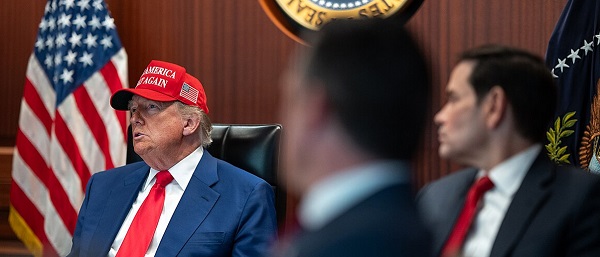
 Daily Caller1 day ago
Daily Caller1 day agoNigeria Would Welcome US Intervention In Massacre Of Christians By Islamic Terror Groups










